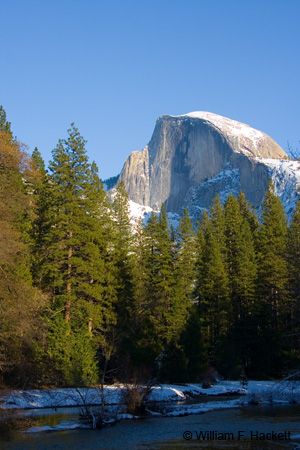Half Dome

Although it is probably one of the the most photographed features of Yosemite National Park, Half Dome begs to be photographed.
And who are we to resist…? 
Half Dome is a granite dome that is located at the eastern end of Yosemite Valley. The top of the crest of the Cretaceous Period granite dome is more than 4737 feet (1444 m) above the floor of Yosemite Valley, at an elevation of 8836 feet (2693 m). The impression that Half Dome is “half” of an original round dome is a false one. Half Dome is nearly as whole as it ever was. The Wikipedia article describes the geology of Half Dome, and the geology of the whole Yosemite area is discussed here.
Half Dome was originally called “Tis-sa-ack,” meaning “Cleft Rock,” by the Native Americans of the region. “Tis-sa-ack” was a woman in a native legend, and the face seen in Half Dome is said to be hers.
Half Dome was declared “perfectly inaccessible” as late as the 1870s. The first ascent was made by George Anderson in October of 1875 by drilling iron eyebolts into the smooth granite. The Cable Route used by hikers today was constructed in 1919 and followed Anderson’s route closely. The trail head for hikers is only 2 miles (3,2 km) from Half Dome, but the winding route of the trail is 8.5 miles (13.7 km) long. The final ascent (400 feet; is accomplished by following a pair of metal cables, which are raised on posts, up the steep but somewhat rounded east face of the peak. Bring gloves for the cables. The Cable Route is rated a class 3 climb and is described in detail in the Wikipedia article. The article also mentions that from 1971 through August 2007, nine people have died falling from the cables, three of them in 2007. In addition, the article notes that lightning strikes can pose a risk. On July 27, 1985, five hikers were struck by lightning, and two of them died. (Note added July 25, 2009: Another hiker fell and died while descending from the summit of Half Dome in June of 2009.) The top of Half Dome is a large, flat area where climbers can relax and rest amid the spectacular views. To one side is the “Diving Board,” where Ansel Adams took his photograph, “Monolith, the Face of Half Dome (1926).”
Alternatively, (for some of you!  ) there are over a dozen rock climbing routes up Half Dome‘s vertical northwest face alone! Other routes exist for the south face and west shoulder. Royal Robbins, Mike Sherrick, and Jerry Gallwas climbed the first modern technical route, the Regular Northwest Face route, in 1957. Their five-day ascent was the first Grade VI climb in the United States.
) there are over a dozen rock climbing routes up Half Dome‘s vertical northwest face alone! Other routes exist for the south face and west shoulder. Royal Robbins, Mike Sherrick, and Jerry Gallwas climbed the first modern technical route, the Regular Northwest Face route, in 1957. Their five-day ascent was the first Grade VI climb in the United States.
The California State quarter includes an image of Half Dome, along with images of the California Condor and John Muir. Half Dome is also included in the logo of the Sierra Club (founded by John Muir, who also spent some time at one of my alma maters, the University of Wisconsin, Madison) and of the game studios, Sierra Entertainment.
Like El Capitan, Half Dome mirrors the weather, seasons, light conditions, and time of day, making it an almost irresistible attraction for photographers and other artists of all kinds.
-Bill at Cheshire Cat Photo™
You can view higher-resolution photos (*generally* 7-30 megabytes, compressed) at the Cheshire Cat Photo™ Pro Gallery on Shutterfly™, where you can also order prints and gifts decorated with the photos of your choice from the gallery. Apparel and other gifts decorated with some of our most popular photos can be ordered from the Cheshire Cat Photo™ Store on CafePress®. Both Shutterfly™ and CafePress® ship to most international locations worldwide!







